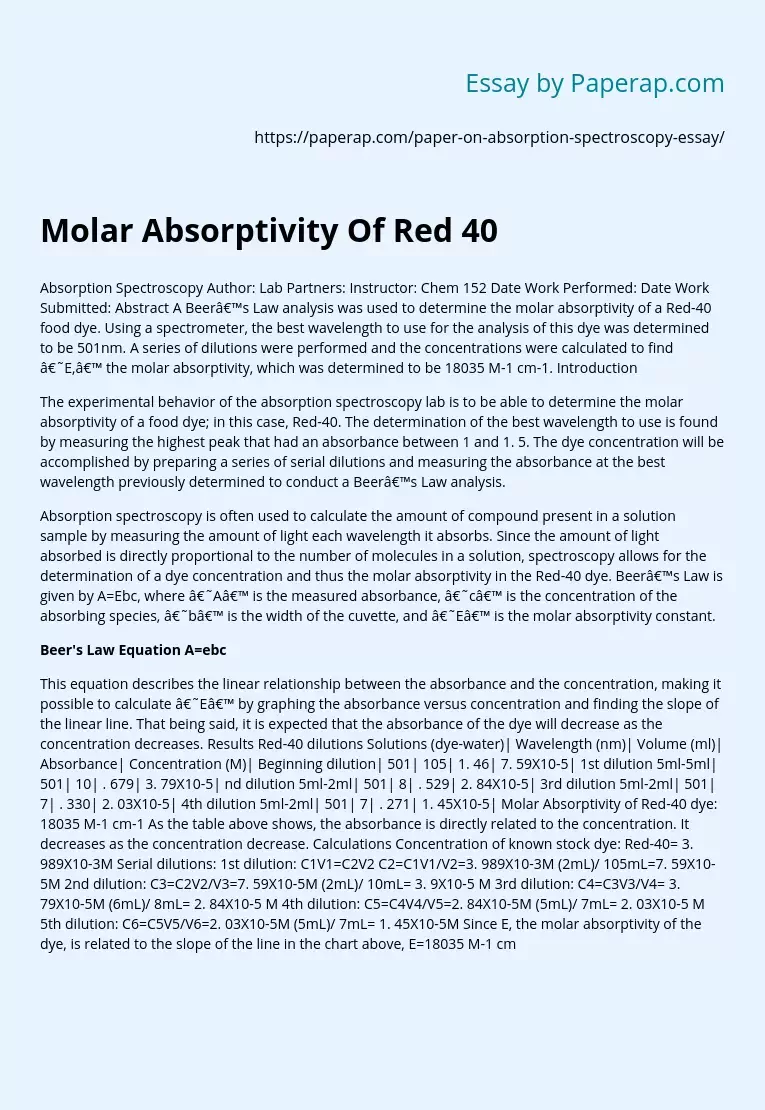Molar Absorptivity Of Red 40
Absorption Spectroscopy Author: Lab Partners: Instructor: Chem 152 Date Work Performed: Date Work Submitted: Abstract A Beer’s Law analysis was used to determine the molar absorptivity of a Red-40 food dye. Using a spectrometer, the best wavelength to use for the analysis of this dye was determined to be 501nm. A series of dilutions were performed and the concentrations were calculated to find ‘E,’ the molar absorptivity, which was determined to be 18035 M-1 cm-1. Introduction
The experimental behavior of the absorption spectroscopy lab is to be able to determine the molar absorptivity of a food dye; in this case, Red-40.
The determination of the best wavelength to use is found by measuring the highest peak that had an absorbance between 1 and 1. 5. The dye concentration will be accomplished by preparing a series of serial dilutions and measuring the absorbance at the best wavelength previously determined to conduct a Beer’s Law analysis.
Absorption spectroscopy is often used to calculate the amount of compound present in a solution sample by measuring the amount of light each wavelength it absorbs.
Since the amount of light absorbed is directly proportional to the number of molecules in a solution, spectroscopy allows for the determination of a dye concentration and thus the molar absorptivity in the Red-40 dye. Beer’s Law is given by A=Ebc, where ‘A’ is the measured absorbance, ‘c’ is the concentration of the absorbing species, ‘b’ is the width of the cuvette, and ‘E’ is the molar absorptivity constant.
Beer’s Law Equation A=ebc
This equation describes the linear relationship between the absorbance and the concentration, making it possible to calculate ‘E’ by graphing the absorbance versus concentration and finding the slope of the linear line.
That being said, it is expected that the absorbance of the dye will decrease as the concentration decreases. Results Red-40 dilutions Solutions (dye-water)| Wavelength (nm)| Volume (ml)| Absorbance| Concentration (M)| Beginning dilution| 501| 105| 1. 46| 7. 59X10-5| 1st dilution 5ml-5ml| 501| 10| . 679| 3. 79X10-5| nd dilution 5ml-2ml| 501| 8| . 529| 2. 84X10-5| 3rd dilution 5ml-2ml| 501| 7| . 330| 2. 03X10-5| 4th dilution 5ml-2ml| 501| 7| . 271| 1. 45X10-5| Molar Absorptivity of Red-40 dye: 18035 M-1 cm-1 As the table above shows, the absorbance is directly related to the concentration. It decreases as the concentration decrease. Calculations Concentration of known stock dye: Red-40= 3. 989X10-3M Serial dilutions: 1st dilution: C1V1=C2V2 C2=C1V1/V2=3. 989X10-3M (2mL)/ 105mL=7. 59X10-5M 2nd dilution: C3=C2V2/V3=7. 59X10-5M (2mL)/ 10mL= 3. 9X10-5 M 3rd dilution: C4=C3V3/V4= 3. 79X10-5M (6mL)/ 8mL= 2. 84X10-5 M 4th dilution: C5=C4V4/V5=2. 84X10-5M (5mL)/ 7mL= 2. 03X10-5 M 5th dilution: C6=C5V5/V6=2. 03X10-5M (5mL)/ 7mL= 1. 45X10-5M Since E, the molar absorptivity of the dye, is related to the slope of the line in the chart above, E=18035 M-1 cm-1. Discussion I believe the molar absorptivity of the Red-40 food dye is 18035 M-1 cm-1. This number is found by graphing the measured absorbance versus the calculated concentration of the diluted dyes and then finding the slope.
According to Beer’s Law equation, ‘E’ is the linear relationship between the concentration and absorbance. So by calculating the slope of the data line, it gives a reliable number as to what the absorptivity of the Red-40 dye is. With that being said, I am rather confident with my answer for the most part. There are a few things that could have affected the accuracy of the molar absorptivity we calculated, which is the various volumes of solution used. Had we used the same volume every time as well as a gradual decrease in the amount of water used in the dilutions, the results could be more reliable.
However, using absorption spectroscopy to monitor the concentration of a reactant in a reaction is very viable. The spectrometer gives an accurate and reliable measurement of the absorbance. All you had to do was to find the measurement at the highest peak. It could have also provided inaccurate readings if the spectrometer was not calibrated corrected with the cuvette of water. Otherwise it is a reliable method to use to find absorbance, calculate concentration, and then the molar absorptivity.
Molar Absorptivity Of Red 40. (2019, Dec 05). Retrieved from https://paperap.com/paper-on-absorption-spectroscopy-essay/

